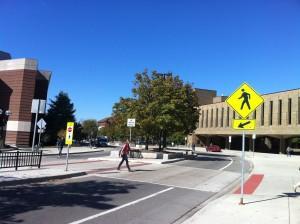 The secret to sustainability might just be walking. At least that was one of the many conclusions reached at the Every Body Walk 2013 Walking Summit. Government shutdown or not, there was work to do, as hundreds of walking (and biking and public transportation) advocates gathered in Washington D.C. last week to talk about how we can change our cities, our suburbs and our rural areas to encourage walking, promote health and enhance sustainability.
The secret to sustainability might just be walking. At least that was one of the many conclusions reached at the Every Body Walk 2013 Walking Summit. Government shutdown or not, there was work to do, as hundreds of walking (and biking and public transportation) advocates gathered in Washington D.C. last week to talk about how we can change our cities, our suburbs and our rural areas to encourage walking, promote health and enhance sustainability.
The interesting thing about walking is that it comes in many forms. There are those who do it for exercise, those who do it to show that a neighborhood is safe, and those who do it as part of their daily public transportation routine, transit being the “middle leg” of a walking trip. It’s even something that can be prescribed—which is exactly what doctors at Kaiser Permanente are doing, “prescribing” walking at different levels for different durations (adverse side effects: sweating) to get their patients moving. But whatever way in which walking is utilized, what’s clear is that it has health and environmental benefits, that we need to promote it, and that, when we do, we must do so with equity in mind. Walking, the conference made clear, needs to be safe, fun and routine.
One of the main themes at the conference was building to support walking. Mixed use buildings and density are heralded as key to walkability because both place important and necessary destinations in the same area, thus making walking possible. But presenters at the conference were quick to point out that walking isn’t just something that a city with a robust public transportation system can accommodate. That is, shopping centers and homes in more suburban and rural area can also be dense and promote mixed use, if we build with this idea in mind. Walkable communities– and all their benefits– are not just something that cities get to have.
Other notable takeaways from the conference centered on a survey about walking perceptions and attitudes, the results of which were released at the conference. The survey found that while people know it’s important to walk, no surprise here, many don’t. Why? The lack of a destination to walk to explains why most people hop in the car instead of use their two feet to reach a destination. There seems to be a gap between motivation and action, a gap that can be tended to by building dense communities and enhancing public transportation in order to make walking the default.
Another key theme was safety: how do we make sure that our streets are safe for pedestrians? Presenters noted that when you create pedestrians, you create an interest group. Pedestrians want safe streets and many will be moved to become advocates in order to make sure streets have sidewalks and safe crossings.
So, walking is the secret to sustainability? Walking is key to health, to community cohesion, and to safety. So long as it keeps people out of cars, in transit and on two feet, walking is absolutely a piece of the sustainability puzzle, and perhaps a not so secret one after all.




